When to Use NIH Stroke Scale: Optimal Assessment Guide

Discover the optimal scenarios for utilizing the NIH Stroke Scale with our informative guide. Enhance your clinical assessment skills and improve patient outcomes.
In the realm of healthcare, the NIH Stroke Scale emerges as a critical tool in assessing and quantifying the severity of stroke-related impairments. Its judicious employment is paramount, ensuring timely and accurate diagnosis, and subsequent treatment decisions that significantly impact patient outcomes. This article elucidates the NIH Stroke Scale's pivotal role, delineating precise scenarios warranting its use within clinical settings. From the acute phase of stroke onset to post-treatment evaluation, understanding when to utilize this standardized assessment tool is instrumental in optimizing patient care and prognosis.
Top 10 Points about NIH Stroke Scale When to Use :
- Understanding the Purpose of the NIH Stroke Scale
- Identifying the Ideal Timing for NIH Stroke Scale Assessment
- Criteria for Administering the NIH Stroke Scale
- Utilizing the NIH Stroke Scale in Acute Stroke Settings
- NIH Stroke Scale: A Tool for Monitoring Treatment Progress
- NIH Stroke Scale in Telestroke and Remote Assessment
- Appropriate Situations for NIH Stroke Scale Implementation
- NIH Stroke Scale: Guiding Decision-making in Stroke Management
- NIH Stroke Scale: Evaluating Stroke Severity and Functional Impairments
- Integrating the NIH Stroke Scale into Comprehensive Stroke Care Protocols
Several facts about NIH Stroke Scale When to Use

Understanding the Purpose of the NIH Stroke Scale
The NIH Stroke Scale is a standardized assessment tool designed to quantify the severity of stroke-related impairments. It aids healthcare professionals in evaluating the extent of neurological deficits and determining appropriate treatment interventions.
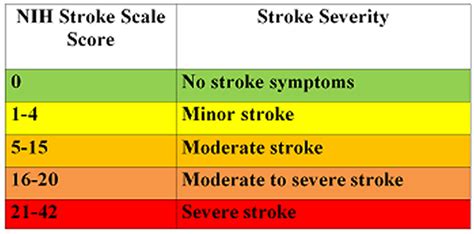
Identifying the Ideal Timing for NIH Stroke Scale Assessment
Timing is crucial when utilizing the NIH Stroke Scale. It is typically administered upon admission to a healthcare facility for suspected stroke, during acute management, and throughout the patient's recovery journey.

Criteria for Administering the NIH Stroke Scale
Healthcare providers should administer the NIH Stroke Scale to patients presenting with suspected stroke symptoms, including sudden onset of weakness, numbness, or speech difficulties. It is essential to use the scale within the recommended time frame after symptom onset.

Utilizing the NIH Stroke Scale in Acute Stroke Settings
In acute stroke settings, prompt and accurate assessment using the NIH Stroke Scale guides treatment decisions, such as thrombolytic therapy or mechanical thrombectomy, to mitigate the effects of stroke and improve patient outcomes.
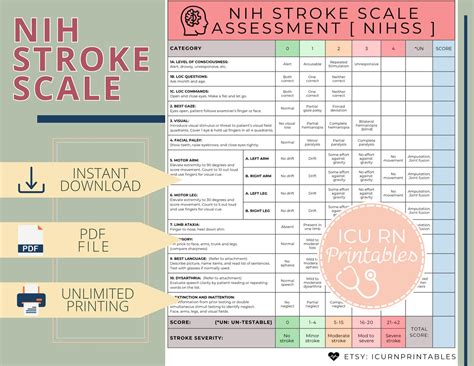
NIH Stroke Scale: A Tool for Monitoring Treatment Progress
Continued assessment with the NIH Stroke Scale allows healthcare providers to monitor patients' response to treatment, adjust therapeutic strategies accordingly, and gauge the effectiveness of interventions in alleviating stroke-related deficits.
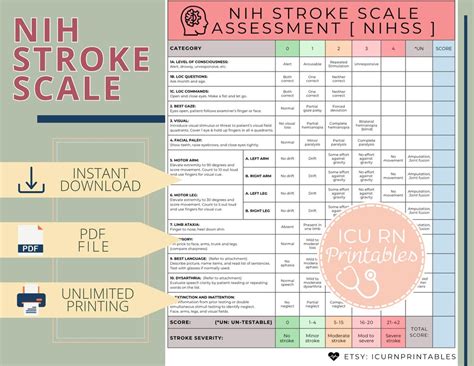
NIH Stroke Scale in Telestroke and Remote Assessment
In telestroke and remote assessment scenarios, the NIH Stroke Scale serves as a valuable tool for evaluating patients in geographically isolated areas, enabling timely diagnosis and treatment recommendations through telemedicine platforms.
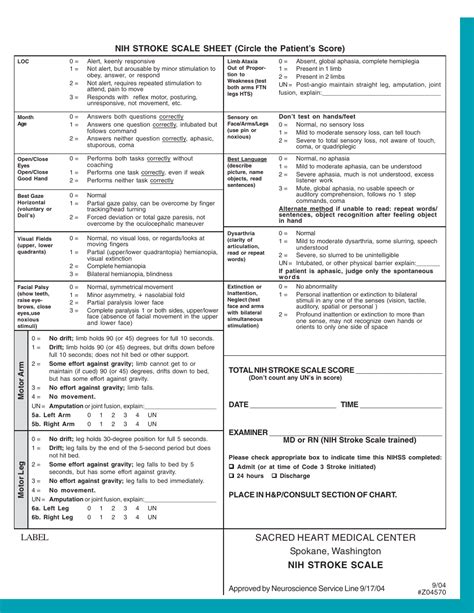
Appropriate Situations for NIH Stroke Scale Implementation
Healthcare professionals should implement the NIH Stroke Scale in all suspected stroke cases, including ischemic and hemorrhagic strokes, to accurately assess neurological deficits and facilitate timely intervention.
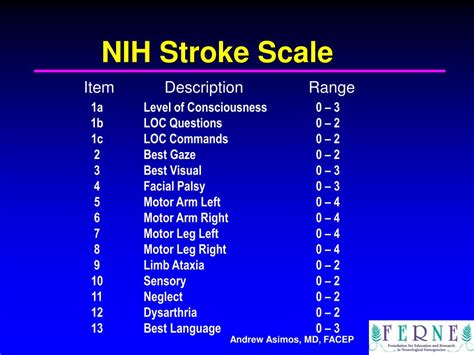
NIH Stroke Scale: Guiding Decision-making in Stroke Management
The NIH Stroke Scale plays a pivotal role in guiding clinical decision-making throughout the continuum of stroke care, assisting healthcare providers in determining appropriate treatment modalities and optimizing patient outcomes.

NIH Stroke Scale: Evaluating Stroke Severity and Functional Impairments
By evaluating stroke severity and functional impairments, the NIH Stroke Scale facilitates comprehensive assessment, aiding healthcare providers in devising individualized rehabilitation plans and optimizing long-term recovery.
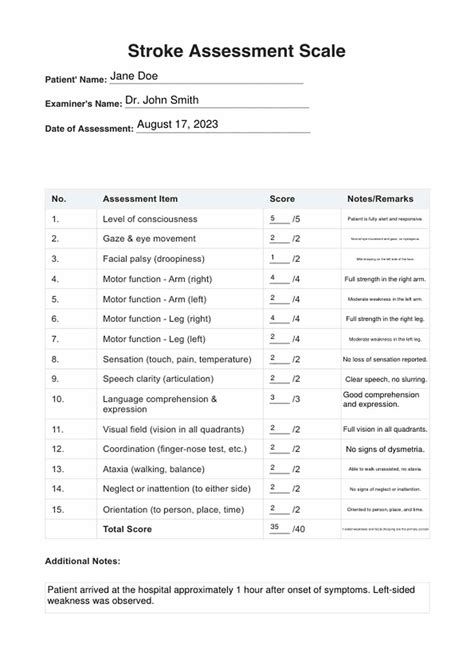
Integrating the NIH Stroke Scale into Comprehensive Stroke Care Protocols
Integration of the NIH Stroke Scale into comprehensive stroke care protocols ensures standardized assessment and treatment strategies, fostering multidisciplinary collaboration and enhancing the quality of stroke care delivery.
Sources: American Heart Association. "NIH Stroke Scale." Stroke. (https://www.ahajournals.org/doi/full/10.1161/01.str.0000186436.09857.99)
NIH Stroke Scale When to Use in Professional's eye
In the realm of healthcare, the
NIH Stroke Scale stands as a crucial tool in the assessment and management of stroke patients, guiding healthcare professionals in determining the severity of stroke-related impairments and devising appropriate treatment plans. Understanding the
optimal timing for utilizing this standardized assessment tool is paramount, ensuring timely intervention and improved patient outcomes. As patients present with a myriad of symptoms suggestive of stroke, ranging from sudden weakness to speech difficulties, healthcare providers must adhere to established guidelines for administering the
NIH Stroke Scale within the recommended time frame after symptom onset. This assessment is particularly vital in
acute stroke settings, where swift and accurate evaluation using the
NIH Stroke Scale informs critical treatment decisions, such as thrombolytic therapy or mechanical thrombectomy, aimed at mitigating the effects of stroke and minimizing long-term disability. Moreover, the
NIH Stroke Scale serves as a valuable tool for
monitoring treatment progress, allowing healthcare professionals to assess patients' response to interventions and adjust therapeutic strategies accordingly. In telestroke and remote assessment scenarios, the
NIH Stroke Scale facilitates timely diagnosis and treatment recommendations, bridging geographical barriers and enabling access to specialized stroke care through telemedicine platforms. Integration of the
NIH Stroke Scale into comprehensive stroke care protocols ensures standardized assessment and treatment strategies, fostering multidisciplinary collaboration and enhancing the quality of stroke care delivery. Overall, the judicious use of the
NIH Stroke Scale in appropriate clinical contexts plays a pivotal role in guiding decision-making, optimizing patient care, and ultimately improving outcomes in stroke management.
Point of Views : NIH Stroke Scale When to Use
As we navigate the complex world of healthcare, one cannot help but marvel at the
NIH Stroke Scale, a tool so revered that it's almost like the Sherlock Holmes of stroke assessment, deciphering clues and unraveling mysteries.Picture this: a team of healthcare professionals gathered around a patient, armed not with magnifying glasses but with the
NIH Stroke Scale, meticulously assessing every nuance of neurological function to determine the severity of stroke-related impairments.Timing is everything in this game of medical detective work. Like a well-timed punchline in a comedy routine, the
optimal timing for using the
NIH Stroke Scale ensures that healthcare providers catch the stroke culprit in the act, enabling swift intervention and better outcomes.It's like a carefully choreographed dance between healthcare providers and the
NIH Stroke Scale, with each step in perfect sync to ensure that no stroke symptom goes unnoticed.In acute stroke settings, the
NIH Stroke Scale takes center stage, guiding treatment decisions like a seasoned director orchestrating a blockbuster movie. Thrombolytic therapy? Check. Mechanical thrombectomy? Check. It's all in a day's work for the
NIH Stroke Scale.And let's not forget about telestroke and remote assessment, where the
NIH Stroke Scale shines as the unsung hero, bridging the gap between patients and specialized stroke care through the magic of telemedicine.So, as we marvel at the wonders of modern healthcare, let's raise a toast to the
NIH Stroke Scale, the unsung hero of stroke assessment, and its impeccable timing that ensures strokes are no match for our medical prowess.
Conclusion :In conclusion, understanding when to use the NIH Stroke Scale is paramount in the realm of healthcare, as it serves as a critical tool in assessing and quantifying the severity of stroke-related impairments. By adhering to established guidelines and administering the scale within the recommended time frame after symptom onset, healthcare providers can effectively evaluate patients presenting with suspected stroke symptoms, facilitating timely intervention and improved patient outcomes. The NIH Stroke Scale plays a pivotal role in guiding treatment decisions, particularly in acute stroke settings, where swift and accurate assessment informs critical therapeutic strategies such as thrombolytic therapy or mechanical thrombectomy, aimed at mitigating the effects of stroke and minimizing long-term disability.Moving forward, as healthcare professionals continue to integrate the NIH Stroke Scale into comprehensive stroke care protocols, it is imperative to recognize its value in standardizing assessment and treatment strategies. By incorporating the scale into routine clinical practice and leveraging its utility in telestroke and remote assessment scenarios, healthcare providers can bridge geographical barriers and ensure timely access to specialized stroke care through telemedicine platforms. The judicious use of the NIH Stroke Scale not only guides decision-making and optimizes patient care but also underscores the collaborative efforts of multidisciplinary teams in enhancing the quality of stroke care delivery. As we navigate the complexities of stroke management, let us continue to uphold the importance of utilizing the NIH Stroke Scale in appropriate clinical contexts, recognizing its indispensable role in improving outcomes and ultimately, saving lives.
Questions and Answer for NIH Stroke Scale When to Use
When discussing the NIH Stroke Scale when to use, people often have additional questions about its application and significance in healthcare. Here are some common queries:
- 1. What is the purpose of the NIH Stroke Scale?
- Answer: The NIH Stroke Scale is a standardized assessment tool used by healthcare professionals to evaluate the severity of stroke-related impairments in patients. It helps quantify neurological deficits and guides treatment decisions.
- 2. When should the NIH Stroke Scale be administered?
- Answer: The NIH Stroke Scale should be administered promptly upon admission of a patient suspected of having a stroke and throughout their treatment journey to monitor progress and guide interventions.
- 3. How does the NIH Stroke Scale assist in treatment decisions?
- Answer: The NIH Stroke Scale provides objective measurements of stroke severity, which helps healthcare providers determine the most appropriate treatment strategies, such as thrombolytic therapy or mechanical thrombectomy.
- 4. Is the NIH Stroke Scale used in all types of strokes?
- Answer: Yes, the NIH Stroke Scale is used to assess patients with various types of strokes, including ischemic and hemorrhagic strokes, to evaluate neurological deficits and guide treatment.
By addressing these common questions, individuals can gain a better understanding of the NIH Stroke Scale's role in stroke management and its importance in facilitating timely and effective interventions.
Label :NIH Stroke Scale, Timing, Healthcare, Assessment
Keyword : NIH Stroke Scale When to Use

Discover the optimal scenarios for utilizing the NIH Stroke Scale with our informative guide. Enhance your clinical assessment skills and improve patient outcomes.
In the realm of healthcare, the NIH Stroke Scale emerges as a critical tool in assessing and quantifying the severity of stroke-related impairments. Its judicious employment is paramount, ensuring timely and accurate diagnosis, and subsequent treatment decisions that significantly impact patient outcomes. This article elucidates the NIH Stroke Scale's pivotal role, delineating precise scenarios warranting its use within clinical settings. From the acute phase of stroke onset to post-treatment evaluation, understanding when to utilize this standardized assessment tool is instrumental in optimizing patient care and prognosis.
Top 10 Points about NIH Stroke Scale When to Use :
- Understanding the Purpose of the NIH Stroke Scale
- Identifying the Ideal Timing for NIH Stroke Scale Assessment
- Criteria for Administering the NIH Stroke Scale
- Utilizing the NIH Stroke Scale in Acute Stroke Settings
- NIH Stroke Scale: A Tool for Monitoring Treatment Progress
- NIH Stroke Scale in Telestroke and Remote Assessment
- Appropriate Situations for NIH Stroke Scale Implementation
- NIH Stroke Scale: Guiding Decision-making in Stroke Management
- NIH Stroke Scale: Evaluating Stroke Severity and Functional Impairments
- Integrating the NIH Stroke Scale into Comprehensive Stroke Care Protocols
Several facts about NIH Stroke Scale When to Use

Understanding the Purpose of the NIH Stroke Scale
The NIH Stroke Scale is a standardized assessment tool designed to quantify the severity of stroke-related impairments. It aids healthcare professionals in evaluating the extent of neurological deficits and determining appropriate treatment interventions.

Identifying the Ideal Timing for NIH Stroke Scale Assessment
Timing is crucial when utilizing the NIH Stroke Scale. It is typically administered upon admission to a healthcare facility for suspected stroke, during acute management, and throughout the patient's recovery journey.

Criteria for Administering the NIH Stroke Scale
Healthcare providers should administer the NIH Stroke Scale to patients presenting with suspected stroke symptoms, including sudden onset of weakness, numbness, or speech difficulties. It is essential to use the scale within the recommended time frame after symptom onset.

Utilizing the NIH Stroke Scale in Acute Stroke Settings
In acute stroke settings, prompt and accurate assessment using the NIH Stroke Scale guides treatment decisions, such as thrombolytic therapy or mechanical thrombectomy, to mitigate the effects of stroke and improve patient outcomes.

NIH Stroke Scale: A Tool for Monitoring Treatment Progress
Continued assessment with the NIH Stroke Scale allows healthcare providers to monitor patients' response to treatment, adjust therapeutic strategies accordingly, and gauge the effectiveness of interventions in alleviating stroke-related deficits.

NIH Stroke Scale in Telestroke and Remote Assessment
In telestroke and remote assessment scenarios, the NIH Stroke Scale serves as a valuable tool for evaluating patients in geographically isolated areas, enabling timely diagnosis and treatment recommendations through telemedicine platforms.

Appropriate Situations for NIH Stroke Scale Implementation
Healthcare professionals should implement the NIH Stroke Scale in all suspected stroke cases, including ischemic and hemorrhagic strokes, to accurately assess neurological deficits and facilitate timely intervention.

NIH Stroke Scale: Guiding Decision-making in Stroke Management
The NIH Stroke Scale plays a pivotal role in guiding clinical decision-making throughout the continuum of stroke care, assisting healthcare providers in determining appropriate treatment modalities and optimizing patient outcomes.

NIH Stroke Scale: Evaluating Stroke Severity and Functional Impairments
By evaluating stroke severity and functional impairments, the NIH Stroke Scale facilitates comprehensive assessment, aiding healthcare providers in devising individualized rehabilitation plans and optimizing long-term recovery.

Integrating the NIH Stroke Scale into Comprehensive Stroke Care Protocols
Integration of the NIH Stroke Scale into comprehensive stroke care protocols ensures standardized assessment and treatment strategies, fostering multidisciplinary collaboration and enhancing the quality of stroke care delivery.
Sources: American Heart Association. "NIH Stroke Scale." Stroke. (https://www.ahajournals.org/doi/full/10.1161/01.str.0000186436.09857.99)
NIH Stroke Scale When to Use in Professional's eye
In the realm of healthcare, the
NIH Stroke Scale stands as a crucial tool in the assessment and management of stroke patients, guiding healthcare professionals in determining the severity of stroke-related impairments and devising appropriate treatment plans. Understanding the
optimal timing for utilizing this standardized assessment tool is paramount, ensuring timely intervention and improved patient outcomes. As patients present with a myriad of symptoms suggestive of stroke, ranging from sudden weakness to speech difficulties, healthcare providers must adhere to established guidelines for administering the
NIH Stroke Scale within the recommended time frame after symptom onset. This assessment is particularly vital in
acute stroke settings, where swift and accurate evaluation using the
NIH Stroke Scale informs critical treatment decisions, such as thrombolytic therapy or mechanical thrombectomy, aimed at mitigating the effects of stroke and minimizing long-term disability. Moreover, the
NIH Stroke Scale serves as a valuable tool for
monitoring treatment progress, allowing healthcare professionals to assess patients' response to interventions and adjust therapeutic strategies accordingly. In telestroke and remote assessment scenarios, the
NIH Stroke Scale facilitates timely diagnosis and treatment recommendations, bridging geographical barriers and enabling access to specialized stroke care through telemedicine platforms. Integration of the
NIH Stroke Scale into comprehensive stroke care protocols ensures standardized assessment and treatment strategies, fostering multidisciplinary collaboration and enhancing the quality of stroke care delivery. Overall, the judicious use of the
NIH Stroke Scale in appropriate clinical contexts plays a pivotal role in guiding decision-making, optimizing patient care, and ultimately improving outcomes in stroke management.
Point of Views : NIH Stroke Scale When to Use
As we navigate the complex world of healthcare, one cannot help but marvel at the
NIH Stroke Scale, a tool so revered that it's almost like the Sherlock Holmes of stroke assessment, deciphering clues and unraveling mysteries.Picture this: a team of healthcare professionals gathered around a patient, armed not with magnifying glasses but with the
NIH Stroke Scale, meticulously assessing every nuance of neurological function to determine the severity of stroke-related impairments.Timing is everything in this game of medical detective work. Like a well-timed punchline in a comedy routine, the
optimal timing for using the
NIH Stroke Scale ensures that healthcare providers catch the stroke culprit in the act, enabling swift intervention and better outcomes.It's like a carefully choreographed dance between healthcare providers and the
NIH Stroke Scale, with each step in perfect sync to ensure that no stroke symptom goes unnoticed.In acute stroke settings, the
NIH Stroke Scale takes center stage, guiding treatment decisions like a seasoned director orchestrating a blockbuster movie. Thrombolytic therapy? Check. Mechanical thrombectomy? Check. It's all in a day's work for the
NIH Stroke Scale.And let's not forget about telestroke and remote assessment, where the
NIH Stroke Scale shines as the unsung hero, bridging the gap between patients and specialized stroke care through the magic of telemedicine.So, as we marvel at the wonders of modern healthcare, let's raise a toast to the
NIH Stroke Scale, the unsung hero of stroke assessment, and its impeccable timing that ensures strokes are no match for our medical prowess.
Conclusion :In conclusion, understanding when to use the NIH Stroke Scale is paramount in the realm of healthcare, as it serves as a critical tool in assessing and quantifying the severity of stroke-related impairments. By adhering to established guidelines and administering the scale within the recommended time frame after symptom onset, healthcare providers can effectively evaluate patients presenting with suspected stroke symptoms, facilitating timely intervention and improved patient outcomes. The NIH Stroke Scale plays a pivotal role in guiding treatment decisions, particularly in acute stroke settings, where swift and accurate assessment informs critical therapeutic strategies such as thrombolytic therapy or mechanical thrombectomy, aimed at mitigating the effects of stroke and minimizing long-term disability.Moving forward, as healthcare professionals continue to integrate the NIH Stroke Scale into comprehensive stroke care protocols, it is imperative to recognize its value in standardizing assessment and treatment strategies. By incorporating the scale into routine clinical practice and leveraging its utility in telestroke and remote assessment scenarios, healthcare providers can bridge geographical barriers and ensure timely access to specialized stroke care through telemedicine platforms. The judicious use of the NIH Stroke Scale not only guides decision-making and optimizes patient care but also underscores the collaborative efforts of multidisciplinary teams in enhancing the quality of stroke care delivery. As we navigate the complexities of stroke management, let us continue to uphold the importance of utilizing the NIH Stroke Scale in appropriate clinical contexts, recognizing its indispensable role in improving outcomes and ultimately, saving lives.
Questions and Answer for NIH Stroke Scale When to Use
When discussing the NIH Stroke Scale when to use, people often have additional questions about its application and significance in healthcare. Here are some common queries:
- 1. What is the purpose of the NIH Stroke Scale?
- Answer: The NIH Stroke Scale is a standardized assessment tool used by healthcare professionals to evaluate the severity of stroke-related impairments in patients. It helps quantify neurological deficits and guides treatment decisions.
- 2. When should the NIH Stroke Scale be administered?
- Answer: The NIH Stroke Scale should be administered promptly upon admission of a patient suspected of having a stroke and throughout their treatment journey to monitor progress and guide interventions.
- 3. How does the NIH Stroke Scale assist in treatment decisions?
- Answer: The NIH Stroke Scale provides objective measurements of stroke severity, which helps healthcare providers determine the most appropriate treatment strategies, such as thrombolytic therapy or mechanical thrombectomy.
- 4. Is the NIH Stroke Scale used in all types of strokes?
- Answer: Yes, the NIH Stroke Scale is used to assess patients with various types of strokes, including ischemic and hemorrhagic strokes, to evaluate neurological deficits and guide treatment.
By addressing these common questions, individuals can gain a better understanding of the NIH Stroke Scale's role in stroke management and its importance in facilitating timely and effective interventions.
Label :NIH Stroke Scale, Timing, Healthcare, Assessment
Keyword : NIH Stroke Scale When to Use
0 komentar